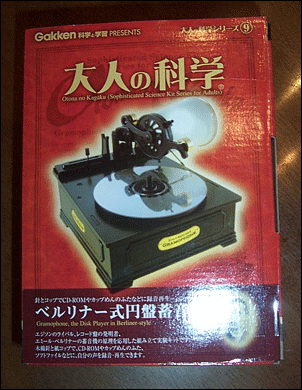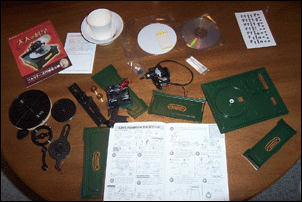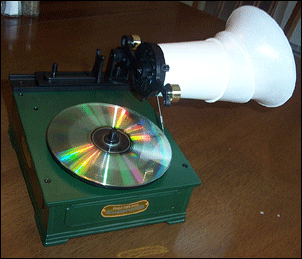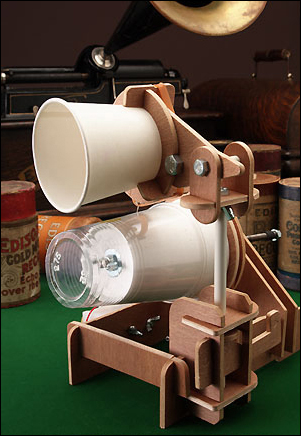I finally got my hands on that functional japanese gramophone model kit thing that I wrote about here. What follows is my review! Get excited!

I’d previously been thwarted in my efforts to order it through Amazon Japan. A few weeks later, the kit showed up in an issue of Readymade Magazine, and they were apparently flooded with requests for further information. Several importers have since picked up the kit for distribution in the U.S. If you contact Readymade about where to purchase the kit, they refer you to verycoolthings.com, which is currently selling the kit for a ridiculous $70 US. Their page for the kit does offer this link to a pdf the English version of the instruction Manual. If you’re feeling thrifty, you can get it for ~ $30.00 (depending on the exchange rate) through Hobby Link Japan by clicking here. Both importers are awaiting November restock shipments.

Once you tear into the box, this is what you’re left with – a bunch of plastic, some styrofoam, a motor, a thumb tack, two sewing needles, and a bunch of tiny screws encased in a blister pack. You also get instructions in both English and Japanese. If you’re the sort of music nerd who thinks this is the greatest thing ever, but you’re hesitant to order because of past issues with language incompatibility, rest assured that the translation of the English instructions is actually really, really good. I flew through the assembly in about an hour.
Below is an image of the model after assembly. In short, you swing a weight into place above the needle, turn on the motor, and Speak into the horn. As the motor turns the platter, the sound vibrations striking the horn are transmitted to the needle, which scratches a linear representation of these vibrations into the surface of the media (In this case a CD-ROM, though several soft, white plastic discs are also included). For playback, the weight above the needle is reduced, and the needle rides in the grooves it had previously scratched out. The vibrations of the needle are in turn transmitted to the horn, producing the audible playback. Woo, science!

I’ve only tested it once, but it works and that’s good enough for me. The audio is predictably thin and warbly, as should be expected when using a rickety plastic turntable and a sewing needle to cut grooves into a CD-ROM. This seemed like as good a reason as any to start figuring out iMovie, so without further ado, the reason you’re all here: A video of the model playing back audio of me singing a bit of ‘Young At Heart’ in a warbly Muppet voice.
Gakken Berliner Gramophone Model – “Young At Heart”
From: My Diningroom Table
The most interesting bit of information I can add to all of this is that this particular model is part of a series of ‘adult education’ models – called Otona no Kagaku. On a whim, I searched the hobby link Japan website for the rest of the models in the series, and was rewarded with the following totally great news:
There’s an Edison Cylinder kit.

Oh, hottest of damns! Somehow I missed this when looking at the Japanese Gakken Website (It could have something to do with it all being in Japanese). It appears to be similar in abstraction to the gramophone kit, constructed of interlocking wood pieces, and the recording is scratched into a plastic cup. Some of the other kits aren’t too shabby either. Here are two ‘automaton‘ kits in the same series.
Clumsy conclusion: Four Stars!